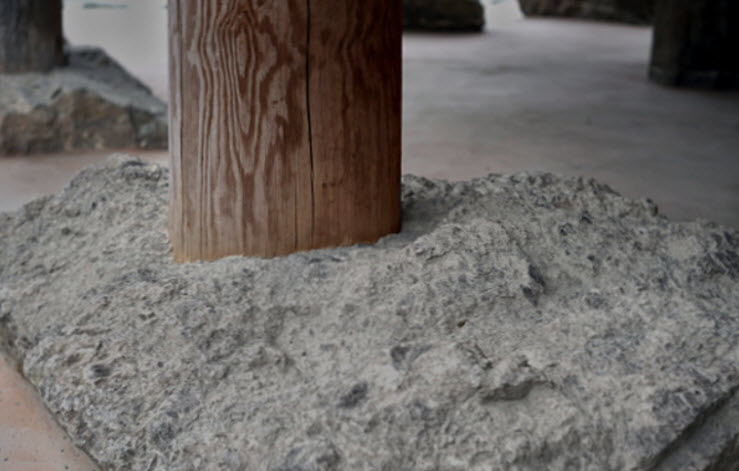
Traditional Korean buildings dating back hundreds of years have held a fascinating secret recently uncovered by Professor Oh. The wooden poles that serve as the foundation for traditional homes and temples seem to be firmly embedded in largely uneven blocks of stone, and the more uneven the stone is, the more firmly embedded the poles appear to be. This is far from the truth however, as the wooden poles are simply situated atop the stones. That people today tend to assume that the poles are embedded in the rock serves as a powerful example of what Professor Oh describes as visual completion. Through his work, Professor Oh has shown that what most of us consider as obvious is nothing more than an illusion in order to make it sense.
The stone-base platform is ubiquitous in traditional Korean architecture, especially amongst the homes and temples of the working class. I remember learning about Grangee(그랭이), which has a ‘V’ shape and is similar to a scriber in Western culture, five years ago. By using a Grangee, Carpenters would draw the curvature of the stone base on the wooden pole and carve so that the two would fit snugly together. The process was so elegant, yet the most elegant detail, that the stone and base were simply atop each other, was obscured from the public.
I realized that we had all been fooled by a coincidental optical illusion, and so I set out to shed light on this matter through my research. I took my camera and travelled across Korea, visiting temples, folk villages and palaces, for a span of two years. When I showed the pictures that I had taken to the students who participated in my experiment, most of them were under the illusion that the wood was embedded in the stone, and that the more uneven the stone, the more firmly embedded the wood was. I believe that this is because the regularity of figural form is critical to the perception of visual completion. The participants reported that the more uneven the stone appears to be, the more they perceived the wood as embedded. This result can be accounted by edge similarity. In more detail, the edges of wooden pole are symmetric and straight, while the edges of the stone base are asymmetric and curvy. This difference of the figural regularity of the both objects become clearer when the stone base is uneven.
The similarity principle is closely related to Gestalt psychology, in which we tend to consider configurations before we consider individual components. To further test the validity of our findings, we carried out additional experiments in which 3D graphic models of the stone-base platform were presented to students. Despite the change in stimulus, similar misperceptions arose.
Making stone-base platform by using Grangee in Korea is a unique method in the world. Through my work, I aim to spread the belief that the stone-base platform must occupy a special place in Korean history, and also provide inspiration for those who revel in the joys of discovery.
Professor Oh Songjoo from the Department of Psychology
Source: https://www.snu.ac.kr/snunow/snu_story?md=v&bbsidx=129194
Written by Cheesue Kim, SNU English Editor, cheesuerocket@gmail.com
Reviewed by Professor Travis Smith, Department of Asian Languages and Civilizations, tlsmith@snu.ac.kr

